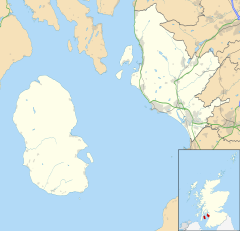| Dreghorn | |
|---|---|
 Dreghorn Main Street, from the war memorial | |
Location within North Ayrshire | |
| Population | 3,450 (2022)[1] |
| Council area | |
| Country | Scotland |
| Sovereign state | United Kingdom |
| Police | Scotland |
| Fire | Scottish |
| Ambulance | Scottish |

Dreghorn is a village in North Ayrshire, Scotland, 3.5 kilometres (2+1⁄4 miles) east of Irvine town centre, on the old main road from Irvine to Kilmarnock. It is sited on a ridge between two rivers. As archaeological excavations near the village centre have found a significant neolithic settlement provisionally dated to around 3500 BC, as well as medieval structures, scholars have suggested that Dreghorn could be Britain's oldest continuously inhabited village. Both Irvine and Dreghorn have grown in size and they are now separated by the Annick Valley Park, which incorporates a footpath and National Cycle Route 73 on the route of the disused Irvine to Busby railway line. It had an estimated population of 3,450 in 2022.[2]
The Church of Scotland Dreghorn and Springside Parish Church, at the centre of the village, dates from 1780. Its octagonal plan, which is unusual in Scotland, was produced by the church's principal benefactor, Archibald Montgomerie, 11th Earl of Eglinton. The village's most famous inhabitant, John Boyd Dunlop, was born at a Dreghorn farm in 1840. When practicing as a veterinary surgeon in Belfast, in 1887 he invented pneumatic tyres for bicycles.
- ^ "Mid-2020 Population Estimates for Settlements and Localities in Scotland". National Records of Scotland. 31 March 2022. Retrieved 31 March 2022.
- ^ "Mid-2020 Population Estimates for Settlements and Localities in Scotland". National Records of Scotland. 31 March 2022. Retrieved 31 March 2022.
